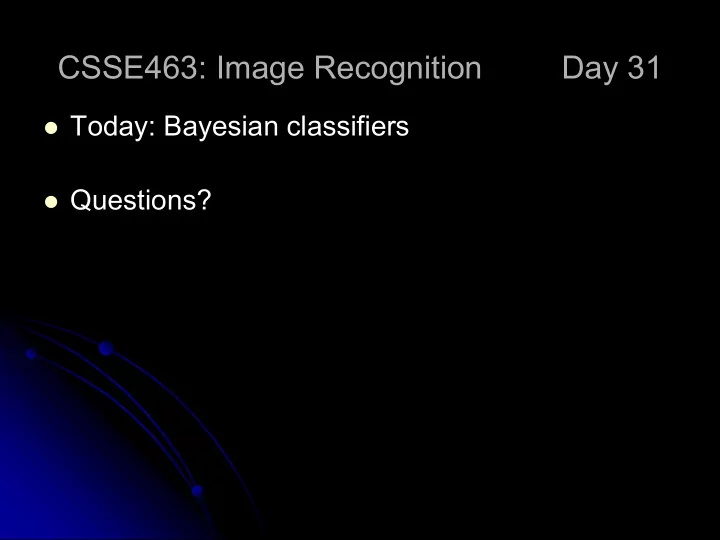

CSSE463: Image Recognition Day 31 Today: Bayesian classifiers Questions?
Bayesian classifiers Use training data p(x) Assume that you know P(x| w 1 ) probabilities of each feature. If 2 classes: P(x| w 2 ) Classes w 1 and w 2 Say, circles vs. non-circles A single feature, x Circles Both classes equally likely Both types of errors equally Non-circles bad Where should we set the threshold between classes? x Here? Detected as circles Where in graph are 2 types of errors? Q1-4
What if we have prior information? Bayesian probabilities say that if we only expect 10% of the objects to be circles, that should affect our classification Q5-8
Bayesian classifier in general Bayes rule: p ( b | a ) p ( a ) Verify with example p ( a | b ) For classifiers: p ( b ) x = feature(s) w i = class P( w |x) = posterior probability w w p ( x | ) p ( ) P( w ) = prior w p ( | x ) i i P(x) = unconditional probability i p ( x ) Find best class by maximum a posteriori (MAP) priniciple. Find Fixed class i that maximizes P( w i |x). Learned from Learned from Denominator doesn’t affect examples calculations training set (or (histogram) Example: leave out if indoor/outdoor classification unknown)
Indoor vs. outdoor classification I can use low-level image info (color, texture, etc) But there’s another source of really helpful info!
Camera Metadata Distributions 0.16 p(FF|I) 0.14 1 0.12 p(BV|I) p(FF|O) 0.9 0.1 p(BV|O) 0.8 0.08 0.7 0.06 0.6 0.04 0.5 0.02 0.4 0 0.3 -6 -0.5 1 0.2 2.5 4 p(FF|O) 5.5 0.1 7 8.5 0 10 p(FF|I) p(BV|I) Subject Distance 11.5 On Off Scene Brightness Flash 0.35 0.6 0.3 0.25 0.4 p(SD|I) 0.2 p(ET|I) p(SD|O) 0.2 0.15 p(ET|O) 0.1 0 0 0.05 0.01 0 0.017 0 0.022 1 2 0.03 p(ET|I) 3 4 0.05 5 p(ET|O) 0.07 7 9 0.1 17 p(SD|I) 0.12 Exposure Time Subject Distance
Why we need Bayes Rule Problem: We know conditional probabilities like P( flash was on | indoor) We want to find conditional probabilities like P(indoor | flash was on, exp time = 0.017, sd=8 ft, SVM output) Let w = class of image, and x = all the evidence. More generally, we know P( x | w ) from the training set (why?) But we want P( w | x) w w p ( x | ) p ( ) w p ( | x ) i i i p ( x )
Using Bayes Rule P( w |x) = P(x| w )P( w )/P(x) The denominator is constant for an image, so P( w |x) = a P(x| w )P( w ) Q9
Using Bayes Rule P( w |x) = P(x| w )P( w )/P(x) The denominator is constant for an image, so P( w |x) = a P(x| w )P( w ) We have two types of features, from image metadata (M) and from low-level features, like color (L) Conditional independence means P(x| w ) = P(M| w )P(L| w ) P( w |X) = a P(M| w ) P(L| w ) P( w ) From SVM Priors From histograms (initial bias)
Bayesian network Efficient way to encode conditional probability distributions and calculate marginals Use for classification by having the classification node at the root Examples Indoor-outdoor classification Automatic image orientation detection
Indoor vs. outdoor classification Each edge in the graph has an associated matrix of conditional probabilities SVM SVM Color Texture Features Features KL Divergence EXIF header
Effects of Image Capture Context Recall for a class C is fraction of C classified correctly
Orientation detection See IEEE TPAMI paper Hardcopy or posted Also uses single-feature Bayesian classifier (answer to #1-4) Keys: 4-class problem (North, South, East, West) Priors really helped here! You should be able to understand the two papers (both posted)
Recommend
More recommend